
Hold your ground when the worried well come into your office this fall demanding prescriptions for Tamiflu and Relenza

Hold your ground when the worried well come into your office this fall demanding prescriptions for Tamiflu and Relenza

As a reflection of the disproportionate impact that the swine flu is having on young children, the CDC’s gift shop in Atlanta is now selling a swine flu toy-a soft 7 inch model of the virus that can be used by adults to explain H1N1 infection to youngsters.
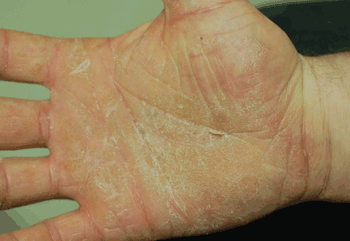
A 46-year-old dentist presents for evaluation of chronic hand dermatitis of 1 year’s duration. He has no other rashes. Standard patch testing was negative. Another physician prescribed a high-potency corticosteroid cream that controls the rash but does not clear it. The patient takes no other medications.

When you encounter unexplained seizures or mental status changes in children who have influenza-like illness, send respiratory specimens for diagnostic testing and promptly start empirical antiviral therapy, especially in hospitalized patients.

Reserve antivirals for adults and children over age 1 who have severe novel H1N1 influenza or who are at high risk for complications.
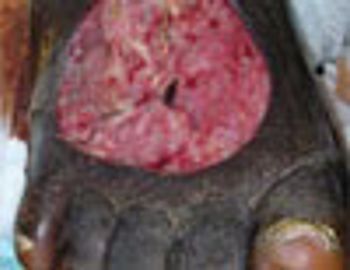
This painful, purulent, malodorous, 5 x 5-cm ulcer developed a few days after the 71-year-old patient had struck his foot against a radiator. For the past 24 hours, he had subjective fevers and chills. He denied recent travel and saltwater or freshwater exposure. He had chronic lymphedema and admitted to drinking alcohol socially.
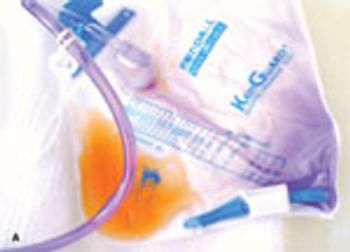
The purple-stained urine bags and tubing of 2 elderly patients are shown here. Neither patient received urine-discoloring medications.
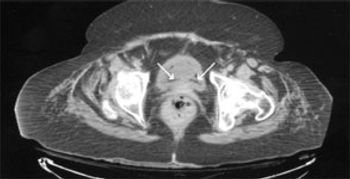
A 77-year-old woman with hypertension, diabetes mellitus with neuropathy and nephropathy, coronary artery disease, and previous stroke with residual right hemiparesis was hospitalized because of abdominal pain, nausea, and vomiting of sudden onset. She also reported subjective fever, dysuria, and foul-smelling urine.

At 1 week postpartum, a 32-year-old woman presents with an itchy rash of sudden onset. Famciclovir, 500 mg bid, is prescribed, but the rash persists.

This pruritic rash developed in a 43-year-old woman who had undergone a lumpectomy and lymph node dissection for breast cancer. She completed radiation therapy and chemotherapy 3 weeks ago. The rash has been present for 5 days. Levofloxacin was started 1 day ago.

A 33-year-old woman presents with arm and leg weakness of about 2 months’ duration.

At least 2 double-blind, randomized, placebo-controlled trials have shown that minocycline is superior to placebo for relief of signs and symptoms of RA.

In 2000, the World Allergy Organization (WAO) published a consensus definition of anaphylaxis as a severe, life-threatening generalized or systemic hypersensitivity reaction. The reaction is caused by the release of bioactive mediators from mast cells and basophils.

When you encounter unexplained seizures or mental status changes in children who have influenza-like illness, send respiratory specimens for diagnostic testing and promptly start empirical antiviral therapy, especially in hospitalized patients.

All elements of the skin are affected by age. In this 2-part article, I discuss how the blood vessels, the lymphatics, and the ground substance- which surrounds these vessels- respond to age, and I show how the aging elements of the vasculature can engender a variety of pathological cutaneous conditions.

Federal health officials stressed the need to start planning now for the fall influenza season when they met with state delegates at the H1N1 Influenza Preparedness Summit. "Over the course of coming weeks and months, we will move aggressively to prepare the nation for the possibility of a more severe outbreak of the H1N1 virus," said Secretary of Health and Human Services Kathleen Sebelius.
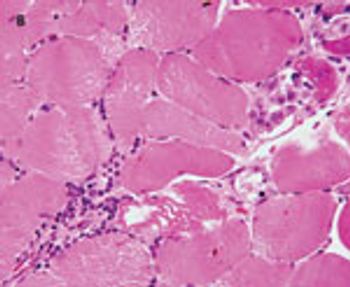
For 2 weeks, a 52-year-old man had progressive fatigue and myalgias. On the morning of presentation, he could not walk. He took no medications but reported chronic, intermittent use of alcohol, intranasal cocaine, and marijuana. He had ingested alcohol 2 weeks earlier and had used cocaine 3 days earlier. Vital signs were normal. The patient had bilateral upper and lower extremity weakness. The proximal muscle groups were affected to a greater degree, with 2/5 strength in the shoulder and hip girdles bilaterally compared with 4/5 strength distally. He had significant difficulty in raising himself to a seated position and when attempting to stand. Results of a complete blood cell count and basic chemistry panel were normal. Serum creatine kinase (CK) was mildly elevated at 9030 U/L. Urinalysis showed 3+ blood, with coarse granular casts but no red blood cells.
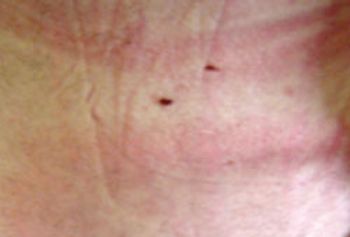
Palpitations and dizziness prompted a previously healthy 21-year-old cable lineman from southeastern Pennsylvania to seek medical attention. An ECG showed first-degree heart block. The young man was scheduled for outpatient cardiology consultation, but his symptoms worsened and he presented to an emergency department with chest pain and fever 2 days later. Further evaluation revealed that for the past 3 weeks he had myalgia; arthralgia; fatigue; and an expanding, erythematous, nonpruritic rash on his trunk and extremities. He did not recall any tick bites.

I advise my patients who are carriers of methicillin-resistant Staphylococcus aureus (MRSA) to keep their fingernails trimmed. Long nails make the subungual spaces good havens for bacteria. S aureus, including MRSA, has been isolated from the subungual spaces of the hands of many at-risk patients who are MRSA carriers
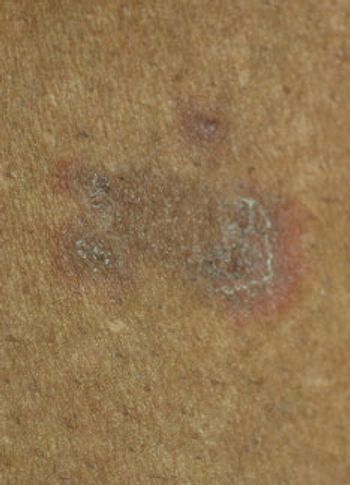
For a few months, a 51-year-old woman has had an asymptomatic rash on her proximal thighs. She claims to have no other rashes and denies any exposure history.
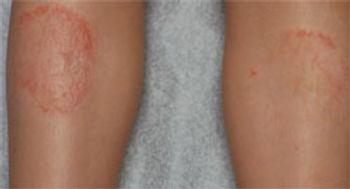
The mother of a 10-year-old boy brings him for evaluation of a persistent rash on his shins of a few months’ duration. The rash has not responded to topical corticosteroids.
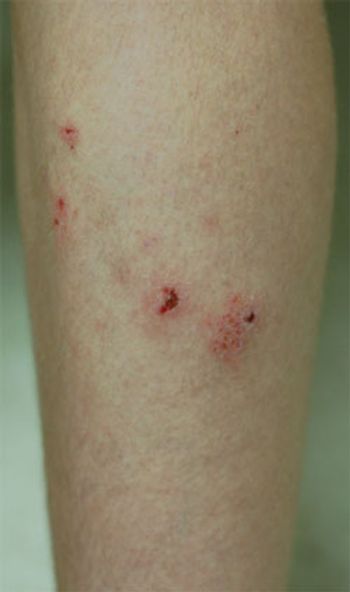
For the past year, a 15-year-old boy has had a pruritic eruption on his shins. His mother suspects that his soccer shin guards are the cause; however, he wears them over his socks. Topical corticosteroids have not been effective.

More than 1 million persons in the United States may have been infected with novel H1N1 (swine) influenza virus, according to US health officials. In a recent media briefing, Dr Anne Schuchat, Director of the National Center for Immunization and Respiratory Diseases, CDC, noted that the infection is continuing to spread well past the typical influenza season in the Northern Hemisphere.

The World Health Organization (WHO) today declared the influenza A (H1N1) outbreak to be a pandemic. The agency decided to raise the pandemic alert level from Phase 5 to 6 based on the rising number of cases seen in Australia and Asia.

If Shakespeare were alive, he would urge caution regarding the “Ides of Influenza.” Recent publicity about global influenza, a result of both potential and real avian and swine flu epidemics, has led to a plethora of theories as well as alarm. How can the primary care practitioner answer questions, educate, prepare, and alleviate anxiety?